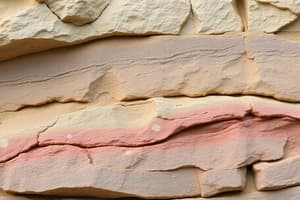Podcast
Questions and Answers
Horizontal beds are characteristic of high-energy water environments, such as strong rivers and oceans.
Horizontal beds are characteristic of high-energy water environments, such as strong rivers and oceans.
False (B)
Horizontal beds form when sediment is deposited in a sloping or vertical position.
Horizontal beds form when sediment is deposited in a sloping or vertical position.
False (B)
Horizontal beds are usually composed of coarse-grained sediment with evidence of cross-bedding.
Horizontal beds are usually composed of coarse-grained sediment with evidence of cross-bedding.
False (B)
Horizontal beds provide valuable information about the geological history of an area.
Horizontal beds provide valuable information about the geological history of an area.
Horizontal beds are only found in lake beds and river deltas.
Horizontal beds are only found in lake beds and river deltas.
Horizontal beds are formed through rapid sedimentation and high current activity.
Horizontal beds are formed through rapid sedimentation and high current activity.
Flashcards are hidden until you start studying
Study Notes
Horizontal Beds
Definition
- A horizontal bed is a type of sedimentary bed that forms when sediment is deposited in a horizontal or nearly horizontal position.
- This type of bed is characteristic of calm and quiet water environments, such as lakes, rivers, and marine basins.
Formation
- Horizontal beds form when sediment settles from suspension in a calm water environment.
- The sediment is deposited in a uniform layer, with minimal disturbance or current activity.
- Over time, the sediment is compacted and cemented together, forming a solid layer.
Characteristics
- Horizontal beds are typically flat-lying and uniform in thickness.
- The sediment is well-sorted and fine-grained, with little to no evidence of cross-bedding or other sedimentary structures.
- The beds may be composed of a single sediment type, such as sand or silt, or may be composed of multiple sediment types.
Examples
- Lake beds and river deltas
- Marine basins and coastal plains
- Floodplains and alluvial fans
Importance
- Horizontal beds provide valuable information about the depositional environment and paleoclimate.
- They can be used to reconstruct ancient landscapes and ecosystems.
- Horizontal beds are also important for understanding the geological history of an area and for identifying potential resources, such as oil and gas.
Horizontal Beds
Definition
- Horizontal beds form when sediment is deposited in a horizontal or nearly horizontal position
- Characteristic of calm and quiet water environments, such as lakes, rivers, and marine basins
Formation
- Form when sediment settles from suspension in a calm water environment
- Sediment is deposited in a uniform layer with minimal disturbance or current activity
- Over time, sediment is compacted and cemented together, forming a solid layer
Characteristics
- Typically flat-lying and uniform in thickness
- Sediment is well-sorted and fine-grained, with little to no evidence of cross-bedding or other sedimentary structures
- May be composed of a single sediment type or multiple sediment types
Examples
- Lake beds and river deltas
- Marine basins and coastal plains
- Floodplains and alluvial fans
Importance
- Provide valuable information about the depositional environment and paleoclimate
- Used to reconstruct ancient landscapes and ecosystems
- Important for understanding the geological history of an area and identifying potential resources, such as oil and gas
Studying That Suits You
Use AI to generate personalized quizzes and flashcards to suit your learning preferences.




